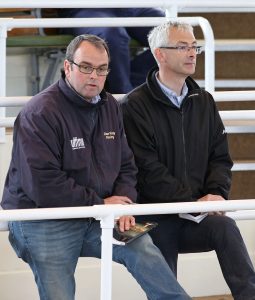Now that the breeze-up season has all but drawn to a close, plenty of encouragement can be taken by yearling vendors that the pinhookers will be reinvesting heavily this autumn following the strongest round of two-year-old auctions in recent memory. Mind you, it would be no surprise if their first port of call is the Keeneland September Sale.
There were 4,479 yearlings catalogued for last year’s fortnight-long epic in Lexington and trawling through as many as possible proved profitable for a number of pinhookers, notably Jim McCartan and Willie Browne.
Their most significant joint-purchase was the $15,000 Darley-bred Street Sense colt with a decent enough pedigree to have raised eyebrows that he sold for so little as a yearling. His dam was not only a juvenile winner and Group 3-placed in France but she is a half-sister to the dual Grade 1 winner Alpha.
The colt’s crib-biting habit seemingly was the cause of his lowly yearling evaluation but this vice was overlooked and eyebrows raised again for the opposite reason when he shattered the Arqana Breeze-up Sale record at €1.4 million. Kerri Radcliffe landed the colt on behalf of the as-yet unnamed operatives behind Phoenix Thoroughbreds who have been prolific spenders in both Europe and America this season.
While the Street Sense colt was the most spectacular coup, he was far from the only profitable American-bred horse to have caused a stir. At Tattersalls’ Craven Sale, McCartan was out in front again with a Scat Daddy colt sold for 675,000gns having been bought as a yearling for $67,000, while a Lemon Drop Kid colt bought by Browne for $70,000 sold for 235,000gns.
Fewer American-sired offspring show up for the Goffs UK Breeze-up Sale, where Kodiac rules the roost and did so again this year, but there was another notable pinhooking strike for McCartan at this sale, when his $5,000 More Than Ready colt sold for £200,000. He is another who will race for Phoenix Thoroughbreds and be trained by Radcliffe’s husband Jeremy Noseda.
Jump brigade welcome
For this avowed follower of the later-maturing types, an interesting development in the breeze-up market has been the increase in the number of National Hunt trainers attending the Guineas Sale at Tattersalls. Admittedly, the horses-in-training section may partly be the draw, but Donald McCain, Alan King, Lucy Wadham, Richard Phillips, Harry Fry and Noel Williams were all among the buyers this year, while Warren Greatrex was also in attendance with his bloodstock agent and wife, Tessa.
Of those trainers more readily associated with jumping, Alan King was the most prolific purchaser, signing for six two-year-olds with Anthony Bromley. King of course also boasts a terrific strike-rate with his Flat runners, so we shouldn’t necessarily expect to see all of these jumping in the future, but the two Champs Elysees colts selected, along with a Youmzain brother to a dual bumper winner, may well have dual-purpose careers ahead of them.

Alan King and Anthony Bromley at the Guineas Breeze-up Sale
Given the current strength of the select National Hunt in-training sales, this is a sensible arena in which to look for those prepared to give these graduates a little time. The ‘ready to run’ concept may be pushed heavily by some sales, but the Guineas Sale has been a welcome addition to the calendar, not only as a back-up option for those who might have missed an earlier sale, but also for horses whose pedigrees suggest a more progressive profile.
The wonderful Trip To Paris has been its most perfect graduate in that he was winning by the July of his two-year-old season but really came into his own as a four-year-old when he won the Ascot Gold Cup and Chester Cup and was beaten only half a length for second in the Caulfield Cup.
It’s not all about worthy stayers, however, as the Nell Gwyn Stakes winner and Guineas third Daban is also a Tattersalls Guineas graduate. She ran only once at two, her victory in a Kempton maiden last November being her only start prior to her Classic trial.
One of the main selling points of the breeze-ups has been the fact that potential owners can watch horses gallop and discern at least some modicum of ability before parting with their cash. As we’ve seen often, buying a breezer doesn’t necessarily mean that they’ll be up to running the following month – though some obviously do.
An early education correctly taught can be no bad thing for a youngster who is then given some time to recover from the exertions of a sales prep after demonstrating that he or she has the physical and mental attributes to cope with training.
While it’s not a concept that has caught on in a purely National Hunt sense, the further development of a sale such as this, perhaps slightly later in the year, for middle-distance, dual-purpose types, could go some way to boosting the dwindling appeal of those yearlings bred to stay and so often overlooked.


